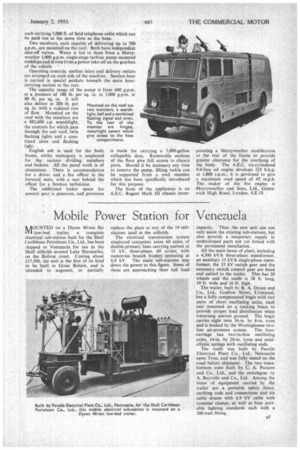Laying a Mile of Hose
Page 40

Page 41

If you've noticed an error in this article please click here to report it so we can fix it.
TWO Merryweather fire engines, each capable of laying a mile of 31s-in..hose, have been ordered by the fire brigade in Trinidad and Tobago, to supplement the Merryweather machines already in service. One has been completed.
Hose is stowed already coupled in a series of long, narrow compartments in the rear of the vehicle and is reached through two hinged flaps, the lower and larger of which carries two castors. When lowered to the ground, the flap serves as a platform over which the hose is paid out as the machine moves forward.
When the upper flap is swung out of the way, ample working space is provided for the fireman who supervises the hose-laying. Contact is maintained between the driver and the hose-layer by means of a pushbutton bell.
Mounted on each side of the hose compartment at the tear are two reels, 136 each carrying 3,000 ft. of field telephone cable which can be paid out at the same time as the hose.
Two monitors, each capable of delivering up to 700
• e.p.m., are mounted on the roof. Both have independent shut-off-valves. Water is fed to them from a Merryweather 1,000 g.p.m. single-stage turbine pump mounted midships and driven from a power take-off on the gearbox of the vehicle '
Operating controls, suction inlets and delivery outlets are arranged on each side of the machine. Suction hose is carried in special pockets beneath the main hosecarrying section at the rear.
The capacity range of the pump is from 600 g.p.rn. at a pressure of 180 lb. per sq. in. to 1,000 g.p.m. at 80 lb. per sq. in. It will also deliver at 200 lb. per sq. in. with a reduced rate of flow. Mounted on the roof with the monitors are a 882,600 c.p. searchlight, the controls for which pass through the cab roof, twin flashing lights and a combined siren and flashing light.
English ash is used for the body frame, whilst mahogany is employed for the various dividing members and lockers. All the panel work is of aluminium. There is accommodation for a drivel and a fire officer in the forward seats, with a seat behind the officer for a fireman technician.
The additional locker space for general gear is generous, and provision is made for carrying a 3,000-gallon collapsible dam. Removable sections of the floor give full access to chassis parts. Should it be necessary any time to remove the pump, lifting tackle can be supported from a roof member which has been specifically introduced for this purpose.
The basis of the appliances is an A.E.C. Regent Mark HI chassis incor
porating a Merryweather modification at the rear of the frame to provide greater clearance for the overhang of the body. The A.E.C. six-cylindered 9.6-litre oil engine develops 125 b.h.p, at 1,800 r.p.m.; it is governed to give a maximum road speed of 45 m.p.h. The maker of the fire engine is • Merryweather and Sons, Ltd., Greenwich High Road, London, S.E.10.




















































































